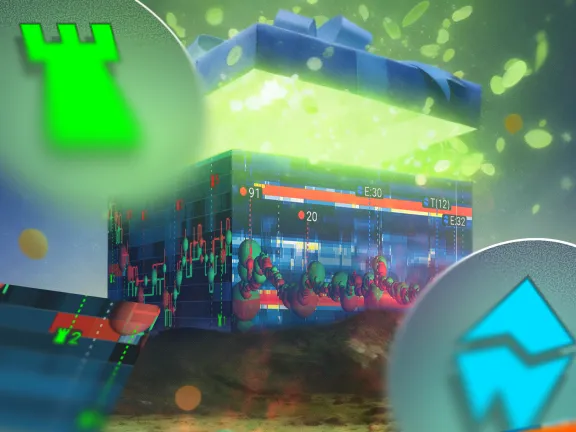

December Trading
Deals Are Live!
Save on Global+, data access,
and add-ons.
See All December Deals

Black Friday
Nov 28-Dec 31
15 days : 20 hours
50% OFF Global+ Quarterly
+ 50% OFF Data (3 months)

Cyber Monday
Dec 1 - Dec 31
15 days : 20 hours
60% OFF Global+ Monthly
+ Data (1 month)

Add-on Deals
Dec 1 - Dec 31
15 days : 20 hours
50% OFF
Add-ons

New Year Sale
Dec 26 - Jan 1
9 days : 20 hours
30% OFF Global+ Lifetime
*Data not included
Crypto
October 22, 2024
SHARE
Solana Crypto: Is It the Next Big Thing in Cryptocurrency?
Do you know about the crypto world’s latest buzz? Maybe “Solana” could be the next big thing! It is even giving heavyweights like Ethereum a serious run for their money.
In this article, we will learn about Solana in detail. To begin with, we will first explain what Solana is, how it operates, and why it’s rapidly gaining traction in areas like DeFi and NFTs. Then, we will explain its unique Proof of History (PoH) system and compare it to Ethereum’s scalability challenges. Not only that, we’ll also touch on key competitors like Cardano and Avalanche, and what major challenges Solana faces in this race. Let’s get started.
What is Solana and How Does it Work?
Solana is a decentralized blockchain platform. It is specifically designed for high-speed and scalable applications. This platform differs from traditional blockchains as it delivers rapid transaction processing at lower costs. Solana can handle around 65,000 transactions per second (TPS), a significant leap over Ethereum’s 15-45 TPS. This efficiency positions Solana as one of the fastest-growing blockchain platforms. It is ideal for developers and users involved in:
- DeFi (decentralized finance),
- NFTs, and
- Other blockchain-based applications.
What is Proof of History (PoH)?

Solana uses a unique “consensus mechanism” called Proof of History (PoH). This technology timestamps transactions and creates a cryptographic proof that events occurred in a specific sequence. By verifying the order of events before finalization, Solana speeds up transaction validation.
Additionally, PoH allows Solana to process transactions in parallel. This enhances its throughput without compromising security or decentralization. This system is more efficient than both Proof of Work (used by Bitcoin) and Proof of Stake (used by Ethereum) because PoH optimizes time and enables more transactions to be processed efficiently.
Solana Has Minimal Transaction Fees
A major benefit of Solana is its low transaction fees. While other networks like Ethereum have costly fees during periods of congestion, Solana’s fees remain minimal. On average, transaction fees are a fraction of a cent. This makes it an attractive option for developers and users looking for cost-efficiency. Furthermore, this affordability allows for the development of applications without high operating costs.
Solana vs. Ethereum: A Rivalry for Blockchain Dominance
Solana and Ethereum differ significantly in terms of:
- Transaction speed,
and
- Scalability
Solana can handle up to 65,000 transactions per second (TPS), while Ethereum operates at around 15-45 TPS. Notably, Ethereum faces congestion during peak times. Often this congestion leads to:
- High gas fees,
and
- Slower transaction processing
However, Ethereum’s scalability is expected to improve with its transition to “Ethereum 2.0” and “Proof of Stake (PoS).” But for now, it struggles to keep up with demand. Compared to Ethereum, Solana’s infrastructure is built to scale efficiently. It also maintains both high-speed performance and low transaction costs. This makes it more appealing for high-frequency applications. Apart from speed and scalability, we can also differentiate both these platforms on this basis:
| Developer Adoption | Smart Contract Capability |
|
|
Use our advanced analytics to evaluate Solana’s market trends. Get started with us on Bookmap today!
Key Challenges for Solana
One of the main challenges Solana has faced is “network outages.” These outages have raised concerns about its reliability. In September 2021, Solana experienced a major “17-hour outage,” which significantly impacted its reputation. The network went down due to overwhelming transaction traffic, caused by bots spamming the system.
This led to concerns about the stability of the network, especially as it aims to support high-frequency applications. While Solana’s team worked quickly to resolve the issue, these outages have significantly affected the trust of users in the network’s ability to scale without disruptions.
Additionally, Solana is not alone in the race to solve blockchain scalability. It faces stiff competition from several other networks. See the graphic below:

These blockchains are also working on scalability solutions. However, each focuses on different strengths. For example,
- Cardano emphasizes rigorous academic research and the use of formal verification methods.
- Avalanche is focused on offering high throughput and low fees.
- Polkadot focuses on interoperability between blockchains.
As these platforms grow and improve, Solana will need to continuously innovate to stay competitive in the blockchain space.
Is Solana the Next Big Thing? Market Sentiment and Investor Interest
Solana has captured the attention of institutional investors. The platform has positioned itself as a serious competitor in the crypto market. Financial institutions, hedge funds, and venture capital firms, such as Andreessen Horowitz (a16z) and Alameda Research, have invested in Solana. These significant investments show that the platform gaining traction. Also, it is being viewed as a blockchain project with long-term potential.
Explore trading opportunities with Solana and other cryptocurrencies with us. Join Bookmap now!
Backing by Major Investment Firms
Influential firms like “a16z” and “Alameda Research” are involved in Solana’s development. This is a major signal of its future potential. For the unaware:
- a16z is known for its focus on tech innovation,
and
- Alameda Research is a prominent crypto trading firm.
Both these firms have placed significant bets on Solana’s growth. Their backing demonstrates that Solana is a stable, scalable, and efficient blockchain. Stay ahead of the curve—track Solana’s market data with real-time analysis on Bookmap. Sign up today!
Solana’s Meteoric Rise in 2021
Solana’s performance in 2021 was remarkable. It rose from a relatively unknown project to becoming one of the top 10 cryptocurrencies by market capitalization. Its price surged and reached over $200 at its peak, a dramatic increase from its launch price of less than $1.
Additionally, this growth outpaced many established cryptocurrencies and cemented Solana as one of the fastest-growing blockchain networks. See the graphic below for what sets Solana apart from competitors like Ethereum:

Use Cases of Solana
Solana is emerging as a significant player in the DeFi space, with popular platforms like “Serum” and “Mango Markets” that are built on Solana. Let’s know more about them:
- Serum is a decentralized exchange. It offers low-cost and high-speed trading. This makes Serum a strong competitor to platforms like Uniswap.
- Mango Markets offer decentralized lending and borrowing.
Both platforms benefit from Solana’s ultra-fast transaction processing. These platforms show how Solana can reshape DeFi by providing scalable and efficient solutions that address congestion issues seen on other networks.
NFTs on Solana

Apart from decentralized exchanges, NFTs are also rising on Solana, largely driven by the platform’s low fees and scalability. Solana-based NFT marketplaces like “Solanart” have also gained traction. More and more artists and collectors are shifting to Solanart as an alternative to Ethereum, which charges higher gas fees. See the graphic below to check what makes Solana an attractive choice:
Conclusion
Solana has positioned itself as a major player in the blockchain space. It rose to prominence in 2021, reaching over $200 per token to become a top 10 cryptocurrency. The platform offers high transaction speeds, scalability, and low fees. Its ability to handle around 65,000 transactions per second makes it ideal for DeFi, NFTs, and other blockchain applications. Backed by leading investment firms like a16z and Alameda Research, Solana has even gained the confidence of established institutional investors.
However, Solana faces challenges, such as “network outages.” Also, some of its direct competitors are platforms like Ethereum, Cardano, and Avalanche. Despite competition and reliability concerns, Solana’s strong growth and developer adoption show its potential to remain a leading blockchain platform.
Moreover, to optimize your trading decisions, you can track Solana’s market data in real-time using our advanced market analysis tool, Bookmap. With it, you can easily analyze Solana’s market trends and get detailed visual insights into liquidity, order flow, and price movements. Wish to make informed decisions with live data visualization? Sign up on Bookmap today!
